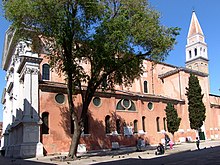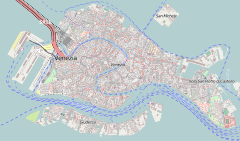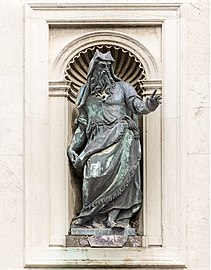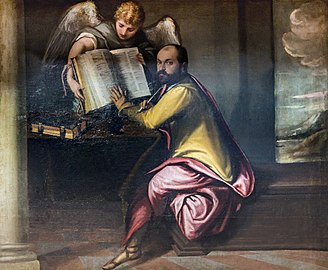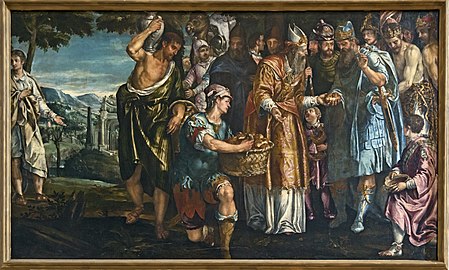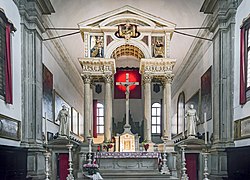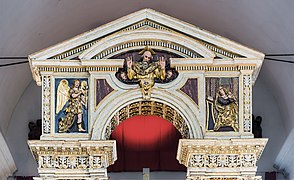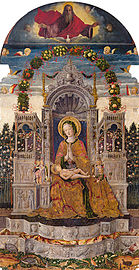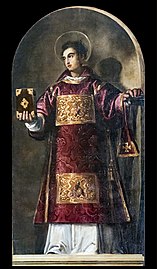|
San Francesco della Vigna
San Francesco della Vigna is a Roman Catholic church in the Sestiere of Castello in Venice, northern Italy.  HistoryAlong with Santa Maria Gloriosa dei Frari, this is one of two Franciscan churches in Venice. The site, originally a vineyard (vigna), was donated by Marco Ziani in 1253 for construction of the monastery. A tiny chapel already on the site recalled the spot where an angel supposedly had pronounced Pax tibi Marce, evangelista meus to the shipwrecked Saint Mark, patron of Venice. The first church at the site was a triple-nave Gothic church by Marino da Pisa. A monastery housed the Frati Minori dell'Osservanza, while the Conventuali occupied the Frari across town. By the 16th century, the church building was in need of repair. Two main impulses led to the reconstruction of this church; one was the reform sweeping the order of the Franciscan Observants, and the other was the wishes of Doge Andrea Gritti, whose family palace neighboured the church. In 1534, this Doge laid the foundation stone for the new church. The nave was roofed over by 1554. ExteriorThe church was designed in sober Renaissance style by Jacopo Sansovino in 1554, with the advice of the Franciscan friar, Fra Francesco Zorzi. Fra Zorzi based the sizing of the various elements on the number three, because of its association with the Trinity: the nave should be nine paces wide and 27 paces long, each side chapel three paces wide. However the white marble façade (1564-1570) was not based on Sansovino's designs, but instead was a product of an Andrea Palladio. It is thought that the patrician Daniele Barbaro lobbied for the commission to be switched from Sansovino to Palladio in 1562, convincing the then Patriarch, Giovanni Grimani. Palladio addressed the challenge of linking the central nave with the side aisles in the façade in an innovative manner. The Corinthian columns in both the center and the sides are perched on the same high plinth, though the central four columns are taller and wider than the lateral ones. The lateral columns support half-pediments that mimic the angle of the central full pediment. Above the central portal is a hemicircular window, interrupted superiorly by a bracket and subdivided into three parts. The façade contains two large bronze statues of Moses and Saint Paul (1592), actively stepping forward from their shallow niches, sculpted by Tiziano Aspetti. At the top of the tympanum, an eagle unfolds a banner stating Renovabitur. Below, a frieze dedication of the church states: Deo utriusque templi aedificatori ac reparatori (God, builder and restorer of both temples) is engraved. Four marble plaques state: Ac cede ad hoc / ne deseras spirituale / non sine iugi exteriori / interiorique bello (Enter here / not abandoning the spirit / not without detaching yourself from the exterior world / and making your interior beautiful).[1] Inside the church, each chapel was sold for 200-350 ducats to aristocratic donors, raising much needed construction funds, granting the rights to place their coat-of-arms in the chapel and to bury their family there. For the right to be buried in the floor of the chancel in front of the high altar, Doge Andrea Gritti paid 1000 ducats. In 1542, Vettor Grimani and his brother Cardinal Marino acquired rights to build the facade for the church. The three sarcophagi for two cardinals and a patriarch from the Grimani family are no longer in place. The facade of the church was ultimately commissioned from Andrea Palladio (1562) by Giovanni Grimani. In the 1950s were cast the 5 bells in B rung with the Veronese bellringing art.
InteriorThe interior of the church has a simplicity and severity befitting a Franciscan church, with plain Istrian stone Doric pilasters. The choir, which in the past was occupied by the monks during services, is behind the altar. The interior contains an alabaster sculpture of St. Louis of Toulouse and an early 15th-century Gothic painting of the Madonna of humility. The Grimani chapel (first in the left aisle) is decorated with ceiling paintings by Battista Franco, and murals and altarpiece by Federico Zuccari. The chapel has been restored by the British charity Venice in Peril, which also restored Palladio's facade in the 1990s.[2] The chapels of the church house masterpieces that both were made for this church or were moved here mainly in the 19th century from shuttering churches, oratories, and monasteries. They belong to some of the most prominent aristocratic families in Venice. Among the chapels, and works therein, are the following (starting from the entrance):[3][4] Right
On the right, a painting depicting "the Last Supper" by Francesco Rizzo da Santacroce. On the left, the "Resurrection of Christ" by Giovanni da Asola. In the middle of the chapel, the tombstone of Bragadin Girolamo Bragadin (1545).
It houses the tomb of two doges: Alvise, doge from 1676 to 1684, and Francesco, doge from 1623 to 1624. Both busts are the work of Antonio Gai.
The right pulpitIt was erected at the expense of Matteo Goretto with an underlying altar dedicated to St. Matthew with a painting depicting the apostle of Francesco Montemezzano. Above the pulpit is another painting by the same author "La Vergine Assunta" (late sixteenth century).
Left
The vault is richly decorated by fifteen medallions known as "Roman" (circular boxes alternated with square boxes). The seven angelic virtues are found in the squares and in the eight circles the human virtues by Battista Franco called Semolei (1561). The altar whose altarpiece shows the "Adoration of the Magi" in 1564 by Federico Zuccari, was painted in oil directly on the marble. This choice explains the state of the work. On both sides in niches of the allegory of the Peace in bronze by Tiziano Aspetti who is the author of the statues of the Palladian facade of the church. Above the altar are three frescoes with the center: "The resurrection of Christ", right: "Elijah cured the son of the widow" and left: "Elijah and the chariot of fire", by Battista Franco. On the right side a fresco framed with gypsy "Resurrected Lazarus" (Resurrezione di Lazzaro) (1561) Federico Zuccari.
Second chapel on the left. Nicola da Urbino, Count of Montefeltro, in 1397 draws up a will by which he gives the Procurator of San Marco 2000 gold coins. He asks that a third of this sum be allocated to the constitution of a chapel in the church of San Marco. The vow will not be respected and it is only 150 years later that the chapel is erected on the occasion of the reconstruction of San Francesco della Vigna. It is under the patronage of Anthony the Great (Sant'Antonio abate). The altar and the marble altarpiece date from 1561, they are due to Francesco Smeraldi. The three statues are of Alessandro Vittoria (1563): in the center of San Antonio Abatea, right St. Sebastian, on the left St. Roch. On the left side of the chapel is a work by Parrasio Micheli "The Fall of the Manna" (Caduta della Manna), on the right side a painting attributed to Parrasio Micheli representing the sacrifice of Melchizedek (Sacrificio di Melchisedech).
Transept left
The Sacristy is organized with a central altar and two laterals. On the left side: The adoration of the mages, a copy of the painting by Federico Zuccari in the Grimani chapel, which is very degraded (oil on marble). This copy was made in 1833 by the painter Michelangelo Grigoletti. On the other side of the left altar are two works by Palma the Younger: San Bonaventura nello studio and San Diego de Alcalá in estasi. The central altar shows a painting by Giuseppe Angeli (1709-1798) The immacolata e santi of 1760. On the right side of the altar a door of John of Capistrano painted around 1710 by Nicola Grassi. From the same author on the right side Antony of Padua. The altar of right is attributed to Sansovino in 1559. On the wall of entrance on the left side The Communion of San Bonaventura (Bonaventure of Bagnoregio) by Nicola Grassi and on the left San Francesco comfortato dall'angelo of the same author.
ChoirThe choir is complex, with a lateral vestibule on either side of the liturgical choir and a choir of brothers. The two are separated by the main altar and a partition. On each side, an apsidal chapel. On the right side of the vestibule is a picture by Palma il giovane: the flagellation; below, an icon (tempera on wood), anonymous work of the end of the XIVth century: Madonna dell'Umiltà .
Transept right
The absidial chapel of right; It is under the patronage of Peter of Alcántara. It was financed and dedicated to the Giustinian "dei vescovi" family (bishops) because this branch of the family had a good number of prelates in these ranks. The vault is decorated with stucco of the eighteenth century, with a central medallion Saint Peter of Alcantara in Glory (1765) by Francesco Fontebasso. On either side of the stalls of the eighteenth century; Above the tables with gypseries. On the right wall: The death of Peter of Alcántara (1765) Francesco Fontebasso, Penance and meditation (1789) by Francesco Maggiotto, Peter of Alcántara and the Queen of Spain, (1765) Francesco Fontebasso. The altar: the table of the altar represents Francis of Assisi receiving the infant Jesus of the Virgin beginning of the seventeenth century by Sante Peranda. On the left wall: The ecstasy of Saint Peter (1765) Francesco Fontebasso, The theological virtues (1785) by Jacopo Marieschi, Peter of Alcántara shows FRancesc ad'Avila the way to paradise (1765) Francesco Fontebasso
The Enthroned Madonna and child (c. 1478) by Antonio da Negroponte. A lunette was added to the painting later, depicting God the Father and the Holy Ghost (early 16th century) by Benedetto Rusconi (il Diana). The transept has a side portal called the Holy Land portal with a Monument to Domenico Trevisan, in right wall portrait of Saint Lawrence of Rome.
Notes
Sources
External linksWikimedia Commons has media related to San Francesco della Vigna (Venice).
|
||||||||||||||||||||||
Portal di Ensiklopedia Dunia
